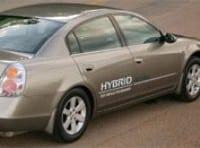
The latest breed of hybrid vehicles, those that run on ordinary fuel and water, are taking the global market by storm. So much so that the oil price is falling daily and OPEC is in a panic.
Of course the water is converted on-board to hydrogen and oxygen, and it’s really the hydrogen that’s giving these cars their extra mileage boost.
This simple concept was developed ten years ago in parallel by Malaysian scientists and an American inventor. The technical obstacles were finally resolved by modern fuel-cell technology and the water hybrids are now mass-produced and commonplace.
Critical innovations in nano-technology, involving membranes and catalysts, were the keys to unlocking the hidden power contained in water – the fuel of life itself.
In the early days of the combustion engine, drag racers used nitrous oxide to give their engines more power. Now we simply add a shot of pure water.
Who would have thought that water would challenge oil as the most valuable natural resource? The oil nations of the middle east have been hard hit by bio-fuels, natural gas and synthetic alternatives. Now water is rising in demand as fast as oil is falling.
Will we ever have power stations running on water?
ANALYSIS >> SYNTHESIS: How this scenario came to be
Power From Water
This is probably one of the oldest dreams in the energy innovator’s repertoire. Urban legends abound about inventors who could make a car run on nothing more than water, but these patents were bought up and suppressed by auto companies and oil producers, according to the myth.
It is of course possible to run a combustion engine on water, but first you need to use some energy – usually electricity – to separate the water into hydrogen and oxygen. You can then burn the hydrogen, or even a mixture of the hydrogen and oxygen, which re-combines to form water vapor.
A hybrid fuel technology is being pioneered in Malaysia, where some of the excess power from a gasoline engine is used to separate water into hydrogen and oxygen. The hydrogen is then fed into the fuel intake of the combustion engine, effectively doubling the mileage obtained from a tank of gasoline.
A similar process is used by an American inventor who initially used the hydrogen-oxygen mixture derived from water as a welding gas, but is also experimenting with a test hybrid vehicle.
Nanotech to the rescue
Nano-technology provides the means to efficiently extract the hydrogen from water. By manufacturing porous catalysts with nano-scale holes and bumps, the surface area available for reaction is exponentially increased, with resulting efficiencies of operation.
Carbon nano-tubes and Y-junctions can be made so small that they act as molecular filters, literally separating larger molecules into their atomic components. At the nano-scale, this is a mechanical reforming of compounds into their original constituents.
Hydrogen fuel cells most commonly use membranes to release electricity from the gas and produce water vapor. In theory at least, a fuel cell can be ‘reversed’ to take electricity and use it to convert water into hydrogen, with greater efficiency than electrolysis. Nanotech advances are greatly increasing the efficacy of these membranes.
Storing the energy
Pure water does not really contain any energy of itself, and is a stable compound. However, most power systems contain inefficiencies in operation, and hybrid vehicles reduce these by capturing excess energy and re-using it when required. This energy is usually stored in batteries and applied to an electric motor, as in the case of most gas-electric hybrids.
The advantage of storing energy in hydrogen (from water) is that it is continuously generated and simultaneously re-used throughout the power cycle, and automatically suspended when the engine is shut off, without the added weight of batteries and electric motors.
A more complex hybrid design uses methanol to power both a combustion engine and a fuel cell – producing electricity for converting water to hydrogen, to boost the combustion engine – and drive an electric motor. Such complexity reduces inefficiencies to a minimum but obviously pushes up costs.
As usual, the most successful approach needs to balance economic feasibility with technology – and capture the imagination of the market.
Warning: Hazardous thinking at work
Despite appearances to the contrary, Futureworld cannot and does not predict the future. Our Mindbullets scenarios are fictitious and designed purely to explore possible futures, challenge and stimulate strategic thinking. Use these at your own risk. Any reference to actual people, entities or events is entirely allegorical. Copyright Futureworld International Limited. Reproduction or distribution permitted only with recognition of Copyright and the inclusion of this disclaimer.
